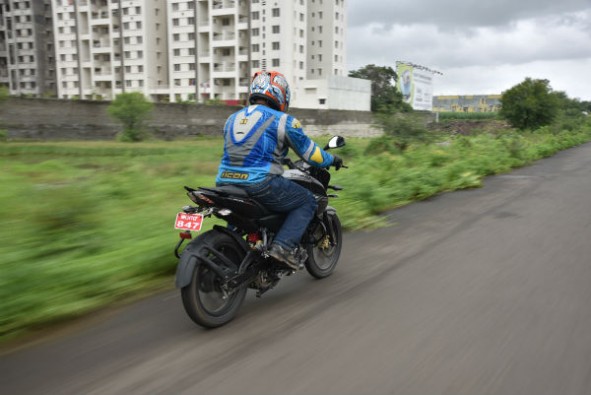The NS160 won’t replace the company’s popular Pulsar 150. The 150 continues to sell in large numbers and it fits a more ‘commuter’ role in the portfolio, while this new NS160 will be squarely aimed at buyers looking for a premium and sporty bike.
On the outside
The original NS200, when launched back in 2012 saw a brand-new design language for the Pulsar family. It was inspired by other high-capacity street nakeds sold in international markets such as the Honda CBR1000R. Even today, this is one of the best-looking bikes in its segment.

This new NS160, is nearly identical to the popular 200’s, which will please enthusiasts. Most of the bike’s external panels, such as the bikini fairing, the headlight, the chunky fuel tank with its extensions and the sharp tail are the same as they are on the 200. The same clip-on handlebars, digital instrument cluster with analogue speedometer, split seats, foot peg brackets and foot pegs, along with the minimalist number-plate holder are part of this bike’s overall design. At first glance, you may even mistake the 160 for its larger sibling, and from the saddle you can’t tell the difference.
Upon closer inspections, you’ll notice thinner front fork, swingarm and tyres. This motor is air cooled, so the radiator shrouds are empty. The motor is also visually smaller, and comes fitted with distinct cooling fins. This bike has no rear disc brake either and there’s a kick-starter on the right side of the engine casing. The NS160 is a good-looking motorcycle but the skinnier forks and tyres make it look a bit odd, it’s got a beefy body and a skinny lower half.

The seating posture is no different from the NS200, making it feel like a much bigger bike than anything else in this segment. Shorter riders may find the saddle height a bit of a bother but its 170mm ground clearance is the highest amongst its rivals, definitely something Indian riders will be grateful for.
Engine and gearbox
The real difference maker though is the engine. The Discover 150 and the AS150 are what inspired this 160.3cc, air-cooled, twin-spark motor. This bike puts out a healthy 15.5hp of peak power at 8,500rpm and 14.6Nm of torque at 6,500rpm.

This bike makes the most power and second-most torque in its segment and this is evident - the motor loves to rev and acceleration is rather brisk. This engine is quite versatile as well, there’s plenty of grunt at low and mid ranges, you can ride around at low speeds of 18-20kph in third gear with ease. And when you’re in the mood, the motor can hold on to speeds of 110kph at around 9,500rpm in fifth gear in relative comfort as well. Its sweet spot is at about 80-85kph in fifth gear.
The bike comes fitted with a five-speed gearbox and it’s been tuned to deliver power in such a way that city rideability is easy. This motor is extremely refined as well, sure there is a typical ‘Pulsarness’ to the way it sounds, but it remains smooth for the most part.
From the saddle
Despite its slim tyres, the NS160 felt absolutely planted, even in the rain. The MRF tyres at both ends do a fantastic job, and thanks to well-tuned suspension and twin-spar frame, this bike’s quite a handler. The NS160’s frame was designed to handle a bigger bike, while this one weighs just 142kg, so you end up with a bike that’s willing to change direction with ease.
The suspension is really well set-up – there’s conventional telescopic forks at the front and a gas-charged monoshock at the back. The bike feels firm, and there is no harshness when riding through rough road. Even bumpy surfaces are dealt with well. This bike offers a good blend of ride quality and handling overall.

There is a 240mm petal disc brake at the front and a 130mm drum at the back, which offer plenty of bite and adequate feel, even in the rain.
Is it worth the money?
Bajaj looks to have made a motorcycle that ticks all the right boxes – it looks great, the motor is highly tractable and the bike handles and rides well too. With a price-tag set at Rs 78,368 (ex-showroom, Delhi), it’s a bike that could make a serious dent in its segment.













